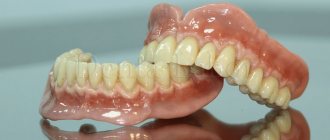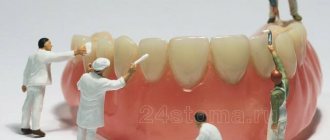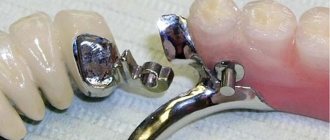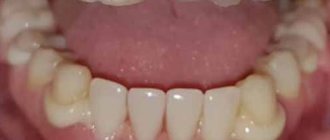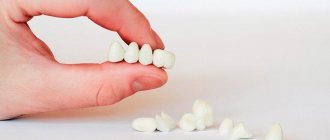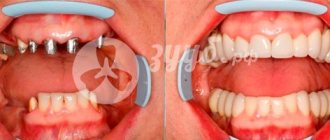The rules for caring for removable dentures are simple and clear - they are very important to follow in order to avoid unpleasant phenomena: shortening the service life of the structure, the appearance of an unpleasant odor, and inflammatory diseases of the oral cavity.
Using a regular toothbrush and toothpaste out of habit can render a denture unusable - this will cause small scratches on the structure and significantly reduce its service life. The result of such improper care is the accumulation of dental plaque and the proliferation of bacteria on the surface due to roughness. That is why it is very important to know several basic rules of care - by following them, you will extend the life of the prosthesis and minimize the risk of complications from wearing it.
Rules of care
Features of hygiene and care of the structure depend on whether you use a cream to fix the prosthesis. Its use allows solving two problems at once: improving the “adhesion” of the structure to tissues, as well as reducing the ingress of food particles under the prosthesis. That is why patients who use such a cream can remove the denture not every time after eating, but once a day.
The general rules for caring for removable dentures are:
- Rinsing the denture after eating - remove the structure and rinse it under running water, removing any remaining food. Be careful - accidentally dropping the prosthesis may cause it to break. It is better to do this over a sink - the likelihood of breakage if dropped is much lower than when washing over a bathtub.
- If your natural teeth are intact, it is important to brush them after eating using a soft toothbrush and toothpaste. Pay attention to your tongue and palate. If your teeth are missing, use a soft gauze swab soaked in mouthwash.
- Caring for removable dentures at home involves cleaning the structure - 2 times a day (morning and evening), thoroughly clean it of dental plaque and the smallest food debris using a soft toothbrush.
It is important to thoroughly clean those parts of the denture that are adjacent to the gums. This is due to their direct contact with soft tissues - careful treatment will avoid inflammatory diseases.
Pay special attention to whether you are bending the metal clasps or the plastic of the prosthesis - you should not do this.
To clean the prosthesis, it is better to choose a low-abrasive paste - a regular one can cause small scratches on the surface of the prosthesis. When buying paste, pay attention to the abrasiveness rating on the package (RDA). Conventional toothpastes have a value of about 60. Children's toothpastes have the lowest abrasiveness. Give preference to products with a value from 0 to 25. In extreme cases, you can use liquid soap, thoroughly rinsing the denture after cleaning.
Choosing the right toothbrush is no less important. Avoid brushes with stiff bristles. It is allowed to use brushes only with soft bristles (marked “soft”).
Reviews
It is impossible not to take into account the positive reviews about removable dentures. Compared to previous years, people are more often turning to dental prosthetics centers. In 2021, 25% more people came to our clinic than in the previous year. And this is not surprising. Technologies are developing, medicine is moving forward, and today dental installation does not last long, and the quality is much higher. And if dental structures left much to be desired, today, when you turn to a professional, you get a high-quality product that is indistinguishable from a natural smile.
Disinfection of the prosthesis
From time to time it is important to completely disinfect the prosthesis. This can be done in two ways:
- Caring for removable dentures - their disinfection - is carried out using special means. They are represented by effervescent tablets, for example, Lacalut Dent, Corega, etc. Such tablets contain special substances that dissolve dental deposits - plaque and tartar, and also destroy pathogens. An additional effect of using tablets is to whiten the structure from stains - removing pigments. The tablets are also designed to protect the metal parts of the prosthesis, if any, from corrosion.
- Ultrasonic bath. Caring for removable dentures using such equipment is the best option. The device makes it possible to clean the structure from dental plaque, pigmented plaque, excellently fights unpleasant odors, and destroys 100% of pathogenic bacteria. One of the additional advantages of using an ultrasonic bath is that there is no need to constantly purchase chemicals or brush the denture. The cost of the bath is, of course, higher than a package of tablets, but it is important to remember its functionality - it can also disinfect other objects.
One tablet should be placed in a glass of water at room temperature and the denture should be lowered into it. As a rule, 3 minutes is enough to obtain the desired result - the structure takes on a neat appearance, and pathogenic bacteria are destroyed. If necessary, at the end of the disinfection process you can additionally use a toothbrush previously soaked in the same product. After this, the prosthesis should be rinsed with running water and your hands should be washed thoroughly.
Accustoming stage
As with any external implantation, you definitely need to get used to installing prostheses. At the initial stage, you will definitely feel severe discomfort. It is possible that unwanted problems with diction will arise and taste sensations will change. Against this background, it is important for the patient to show psychological resilience.
Strong vomiting and excessive salivation are considered completely undesirable phenomena.
Oddly enough, a person gets used to permanent dentures faster than removable ones. The entire adaptation period depends on the following factors:
- Product size.
- Fixation method.
- Degree of fixation.
- The body's reaction to the introduction of a foreign body.
- On the nature of the impact.
There are times when the denture rubs the gums. In this situation, you definitely need to visit the dentist, otherwise a strong inflammatory process will begin.
To make the addiction process easier, you need to adhere to the following rules:
- Keep your teeth and dentures clean.
- Clean installed structures using dental floss.
- Massage your gums regularly.
- In case of gum rubbing, use a fixing cream, for example, Corega.
Rules for storing dentures
The care and storage of removable dentures requires compliance with a number of recommendations. The most important of them is the mandatory removal of the structure before going to bed - this helps to avoid premature deformation. The rules for storing removable dentures are as follows.
For the first 10-14 days after manufacture, the dentist may recommend wearing the denture as much as possible, removing it only for a short period, this allows you to quickly adapt to the new design. However, after this time, the tissues of the oral cavity will need rest - it is important to remove the denture for at least 6 hours a day. Caring for nylon removable dentures requires maintaining moisture so that they do not lose their shape - the same is true for plastic structures.
If you are removing dentures for a long time, it is important to place them in a water solution or a special solution for soaking dentures. You can use a glass of water, disinfectant liquid, or a special storage container. The last option can be used for any dentures - you can care for removable dentures made of plastic or nylon, structures containing metal elements. The container looks like a neat box - opaque and hermetically sealed.
Its use helps prevent mechanical damage to the prosthesis and the proliferation of bacteria. Also, if you need to take the prosthesis with you, such a container will be indispensable - it will provide protection against the ingress of microorganisms.
Pay attention to the quality of the water in which you soak the prosthesis if the structure contains metal elements - water with the smell of chlorine can cause the metal to darken.
Do not forget that the main reasons for denture deformation are drying out of the structure, as well as placing it in hot water. If this happens, and the denture after installation causes discomfort, pain while wearing or eating, consult a doctor - most likely, a new denture will be required.
How many implants are needed to install a prosthesis?
2 implants
To significantly improve the fixation of a removable denture, it is enough to install only two dental implants. After their “engraftment”, which takes 3-4 months, they are used as supports to hold the prosthesis. Special abutments are screwed to the implants, having locking fastenings in the form of a “ball” (Photo 3.2). The reciprocal part is fixed into the removable denture. When “putting on” the prosthesis, “the locks click into place” and it holds perfectly. In this case, it is possible to reduce the boundaries (sizes) of the prosthesis, sometimes significantly reducing the size of the plastic palate. Of course, the comfort and quality of life increases significantly.
Photo 3.2. “2 implants on the lower jaw for fixation of a removable denture”
Photo 3.3. "Removable dentures for the upper and lower jaw"
Photo 3.4. “Happy patient: good fixation, standard size prosthesis, beautiful smile.”
4 implants
If conditions allow the installation of 4 implants, it is possible to make a beam structure, that is, a removable denture on a beam . All implants are connected by a milled metal beam with locking “retaining elements”. The response part is located in the prosthesis.
Photo 3.5 “4 implants on the upper jaw + cast metal beam for fixing a removable denture.”
Photo 3.6. “Removable denture for the upper jaw: view from the outside and from the inside.”
Photo 3.7 “Removable denture for the upper jaw: view from the outside and inside.”
In this case, the design, in fact, resembles a bridge prosthesis (dental bridge), but unlike a bridge prosthesis, it is removable . The entire load is distributed to the implants. The fixation is very rigid, the prosthesis “holds tightly.” On the upper jaw, the artificial palate is completely absent. The boundaries of the prosthesis are reduced, which is very comfortable to use. A very beautiful and convenient option that allows you to remove and thoroughly clean the prosthesis outside and inside, as well as the beam itself.
Photo 3.8. “Happy patient: good fixation, reduced denture, beautiful smile.”
3.9 “Happy patient: good fixation, reduced denture, beautiful smile.”
But there is no limit to perfection. Using the same four implants, it is possible to manufacture a non-removable prosthesis using the “all-on-4” technique.
Photo 3.10 “4 implants on the bottom for fixing a fixed prosthesis.”
Photo 3.11 “The fixed prosthesis on the lower jaw is fixed. The patient is very satisfied."
Photo 3.12 “The fixed prosthesis on the lower jaw is fixed. The patient is very satisfied."
A separate article is devoted to this unique type of prosthetics.
6 or more implants
If you install from 6 to 8 implants, then it becomes possible to make a non-removable, comfortable, miniature and beautiful prosthesis, as close as possible in comfort and appearance to your natural teeth.
Photo 3.13 Complete denture for the upper jaw with complete absence of teeth supported by 6 implants.
Photo 3.14 “Happy patient: excellent fixation, miniature prosthesis, beautiful smile.”
You can read about fixed prosthetics in the absence of teeth here.
Denture care products
There are two categories of care products for removable dentures:
- Fixing. They are used only in conjunction with removable structures and are designed to ensure the strength of their retention in the oral cavity. In addition, reliable fixation helps restore diction, protect soft tissues from injury under constant mechanical influence of the artificial structure, and improve chewing function. There are several types of fixing agents:
- powder - it is sprayed in a thin layer onto the surface of the prosthesis, after which the structure is put on and pressed to the gums for a certain time. As a rule, such a remedy is widely used for low salivation; it allows you to securely fasten the prosthesis;
- cream - it is applied in a thin layer to the edge of the prosthesis - dotted or in strips. It is worth noting that a large volume of applied product will lead to its removal to the outside - it is important to observe the measure. This cream is designed not only to fix the prosthesis in the oral cavity, but also to create a shock-absorbing pad to protect the gum tissue from mechanical stress.
- strips are special products that are used when the patient cannot get used to the presence of a foreign body in the oral cavity. The strips are placed under the prosthesis, which allows you to soften the pressure and fix the structure.
- Cleansing. Cleaning products for the care of removable dentures are presented as follows:
- a brush with soft bristles - it is important to change it monthly, and if inflammatory diseases of the oral cavity occur, the replacement is made prematurely;
- brush - allows you to clean the spaces between teeth;
- paste - with low abrasiveness or without abrasive particles at all;
- rinse aid - a liquid with a disinfectant effect: tablets that dissolve in water or pharmaceutical products with an antibacterial effect;
- an irrigator is a device that allows you to wash out food particles and dental plaque even from hard-to-reach places; you can choose a compact irrigator for home use;
- floss - dental floss for cleaning interdental spaces and the peri-gingival area.
As a rule, the cream lasts for at least 12-24 hours, after which the product is dissolved by saliva. This requires rinsing the prosthesis and removing any residue.
Following recommendations for the care of removable dentures will ensure wearing comfort, prevent possible complications and extend the life of the structure. The installation of a prosthesis by an orthopedic dentist is necessarily accompanied by an explanation of the rules for caring for the structure and, if necessary, prescribing the products that will be required for care.
Where to store removable dentures?
If the patient does not want to sleep with the product, the patient places the device in a container with a solution that eliminates all remaining food and plaque. Container - a special device or a kitchen glass. You can find this solution at the pharmacy.
It has disinfecting functions:
- Destruction of malicious infections.
- Dissolving food residues that are stuck.
- Removing plaque.
Being in a liquid medium helps maintain shape. Upon waking up, the patient finds the structure clean and disinfected, ready for use.
It is recommended to purchase a container because:
- They take it on the road, to work, for a walk.
- It has a holder that you can take out without getting your hands dirty.
- The product is made of polypropylene. This gives quality and reliability to the prostheses.
During the first days, do not remove the prosthesis even at night.
Getting used to removable dentures is one of the most difficult things. The organs of the oral cavity and the brain must adapt to noticeably changed conditions, and for this purpose the device should be worn around the clock. You should not remove your denture at night or before meals, no matter how uncomfortable it may be to sleep and chew with it. Get through the first days - then it will be easier. After at least two to three weeks, the discomfort should go away. If a person often removes the prosthetic structure, then addiction can take months.
To facilitate the chewing process, food can first be chopped into small pieces. But as quickly as possible, switch to eating foods of the usual consistency, because this is exactly why you installed a removable denture.
Actively combat drooling and nausea
The body perceives any foreign body in the mouth as food and therefore turns on the salivary glands. Drink water in small sips, suck on mints, and eat small, frequent meals. All this will help reduce drooling. It is especially important to prevent the feeling of hunger, which also increases saliva production.
Another unpleasant symptom is nausea and vomiting. They often bother patients with removable prosthetics of the upper jaw. Relaxation techniques, rinsing the mouth with salted water, and sucking on mint candies can help cope with this kind of discomfort.
